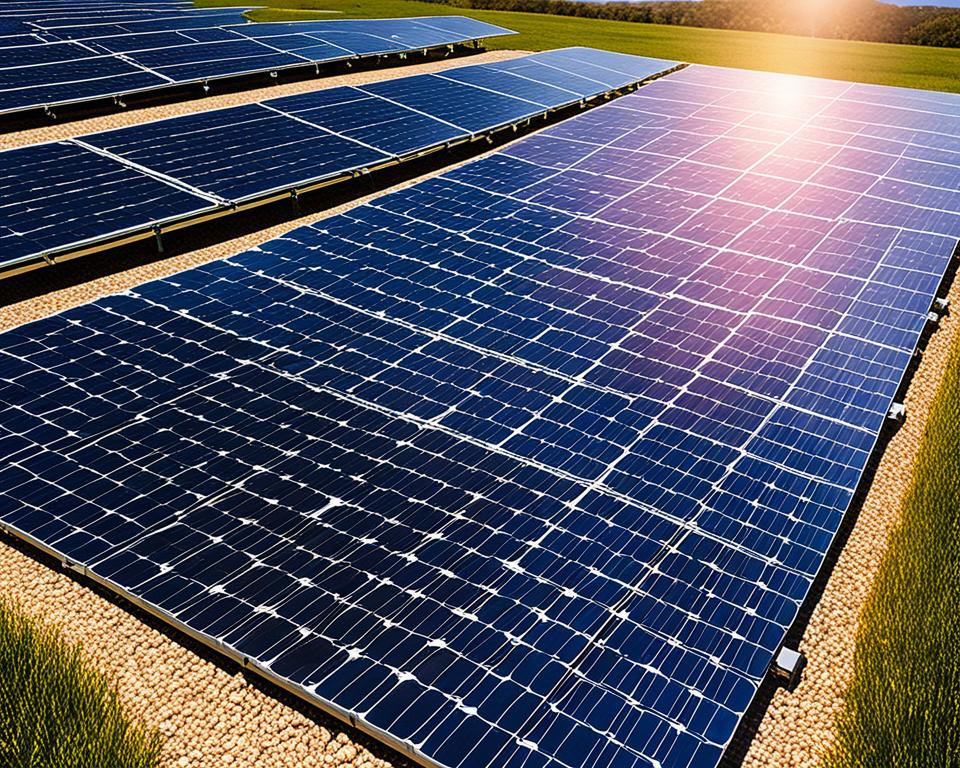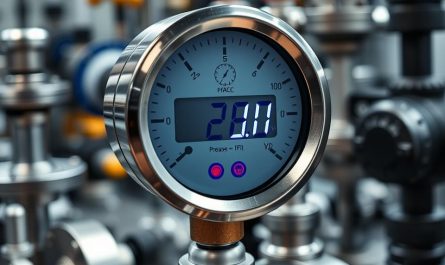The world is turning to renewable energy, and 400-watt solar panels are leading the way. They are changing how we power our homes and businesses. These panels offer big energy benefits and save costs.
Solar panels for homes have jumped in power from 300 watts to 400 watts. This change means more electricity can be made per day, up to 1.5 kilowatt-hours. This is enough for a full day of TV use. So, buying a 400-watt solar panel is a great way to save on your energy bill.
Buying a top-notch 400-watt solar panel can be expensive, around $250 to $300 at first. But the payoff over time is huge. A 7-kilowatt solar system with these panels might initially cost $19,950. After the U.S. federal solar tax credit, this drops to about $14,000. For a typical home, this means adding 15 to 30 panels on the roof. Such a system could cut the yearly power bill by $1,716.
Read interesting things at : grenzgamer
Key Takeaways
- 400-watt solar panels are the new standard for residential and commercial solar installations, offering higher energy output and efficiency compared to previous generations.
- A single 400-watt solar panel can generate between 1.2 to 1.5 kWh of electricity per day, enough to power a television for a full day.
- The cost of a 400-watt solar panel ranges from $250 to $300, and a 7 kW solar system using these panels can cost around $14,000 after the federal tax credit.
- Most homeowners will need between 15 to 30 400-watt solar panels to meet their energy needs, with the potential to save up to $1,716 per year on electricity bills.
- 400-watt solar panels are a popular choice due to their high efficiency, affordability, and widespread use in residential solar installations.
Introduction to 400 Watt Solar Panels
What is a 400 Watt Solar Panel?
A 400 W solar panel makes 400 watts of instant DC electricity under perfect conditions. It has 60 to 66 cells and is about 5.4 by 3.25 feet in size.
Standard Test Conditions (STC) for Solar Panels
STC are standards used in labs to test solar panels’ performance. They include sunlight at 1000 W/m2, 25°C cell temperature, and 1.5 air mass. These standards let us compare different solar panels fairly.
But, the real world is different from a lab. Weather, temperature, and shadows can reduce a panel’s power. Even though a 400 W panel may not reach 400 watts, systems are set up to work well in daily life. They still provide enough power for your home.
The Benefits of 400 Watt Solar Panels
High Energy Output
A 400-watt solar panel can give you 1.2 to 1.5 kWh of electricity daily. This power is great for running things like TVs, laptops, and fans in your home. These panels give out a lot more energy than smaller ones. So, you can use less energy from the grid. This can lower your power bill and help the planet. Because they make so much power, 400-watt solar panels are a top pick for homes and businesses. They want to cut costs and rely more on solar energy.
Space Efficient Design
400-watt solar panels are not too big, about 79 x 39 inches in size. This means you need fewer of them to power your home, unlike smaller panels. Their size and power are a great fit for roofs with not much space. You get more power in less area with these panels. So, if your roof space is small, 400-watt solar panels are a smart choice. They let you create enough energy without a huge solar setup.
Cost-Effective Solution
A top-notch 400-watt solar panel usually costs $250 to $300. This is a good price for the energy they offer. With the solar tax credit, a 7 kW system’s price can go from $19,950 to about $14,000. That’s a big saving for homeowners who choose these panels. If you use 21 panels, you could save $1,716 every year on energy. This shows the savings you can enjoy over time with these efficient panels.
How Much Energy Does a 400 Watt Solar Panel Produce?
A 400-watt solar panel makes between 1.2 and 1.5 kilowatt-hours (kWh) each day. This number changes because of where you are and the weather. The energy it makes also depends on your location. Solar panels in the South and West make up to 43 kWh each month. In contrast, ones in the Northeast make around 34 kWh monthly. Even though a 400-watt solar panel is supposed to make 400 watts in a perfect setting, you usually get between 280 to 360 watts. This is because of clouds, temperature, and the angle of the sun.
Factors Affecting 400 Watt Solar Panel Output
Many things affect the efficiency of 400-watt solar panels. This includes where they are placed, how they face, and the local weather. All these factors work together to determine how much energy the panels produce.
Geographic Location
The place where you install a solar panel is crucial. Sunny spots, like in the Southwest, can produce more power. For instance, a panel in the South might make 43 kWh per month. But, one in the Northeast might only do 34 kWh monthly. More sun means more power, highlighting the importance of location for solar efficiency.
Tilt Angle and Orientation
How you tilt and turn the panel also matters. A correctly positioned panel can catch more sunlight, increasing its energy production. It’s key to think about the sun’s angle, the season, and the time of day. Changing the angle and direction of the panel can boost its output. But, it might need extra gear and care.
Temperature and Weather Conditions
The weather can either help or hinder a solar panel’s work. Extreme hot or cold can lower a panel’s power creation, with heat being more damaging. Clouds and rain can also block the sunlight the panel needs to function well. Even though panels are made to handle different weather, unexpected conditions may still lessen their power output.
400 Watt Solar Panel Cost and Pricing
Average Cost per Panel
A 400-watt solar panel costs between $250 and $300 each. It’s an affordable choice for both homes and businesses. They are good for anyone interested in solar panel pricing and renewable energy investment. But the price might go up to $1,000 for premium models. This depends on the brand, quality, and the tech.
System Installation Costs
A complete solar panel system with 400-watt panels might cost around $19,950 initially for a 7 kW setup. After getting the federal solar tax credit, this price can go down to about $14,000. This makes it more doable for many people.
Not just the panels, but the total setup including inverters, wiring, and labor adds to the cost. Before any discounts, a 7 kW system is about $19,950. This includes the expense of setting everything up. With the federal solar tax credit, the cost goes down to $14,000. It turns into a better deal for homeowners.
Choosing the Right 400 Watt Solar Panels
Homeowners and businesses looking for reliable 400-watt solar panels have several options. Brands like Qcells, Canadian Solar, and SunPower are known for their high-quality solar products. These companies have a solid reputation for their solar panels’ performance.
Top 400 Watt Solar Panel Brands
Choosing the best 400-watt solar panel brand involves looking into a few key factors. Efficiency, warranty, and the manufacturer’s reputation matter a lot. Despite the price, opt for a brand that offers great customer service and has a history of dependable products.
Panel Efficiency Ratings
400-watt solar panels typically have efficiency ratings ranging from 18% to 22%. This means they can turn sunlight into electricity at a better rate compared to lower wattage units. Take, for instance, the VTOMAN 400W Foldable Portable Solar Panel. It has an efficiency as high as 23%. This shows how photovoltaic technology is improving in this power category.
Panel efficiency directly impacts how much energy and savings you get from your solar system. Higher efficiency panels produce more electricity from the same space. This is why efficiency is critical for a successful 400-watt solar system.

400 Watt Solar Panel Applications
Residential Solar Power Systems
400-watt solar panels work really well for homes. They can power lots of things like TVs, laptops, and even the big appliances like fridges and washers. Homeowners find them great because they reduce how much electricity they buy from the grid. They can produce between 1.2 kWh and 1.5 kWh each day. This is a big help in meeting home’s power needs with renewable energy.1
Commercial and Industrial Use
These panels aren’t just for homes. They’re also used by businesses and factories. What’s cool is that businesses can set up systems to match exactly how much energy they need. This works whether it’s a small office or a huge factory. Using these solar panels helps companies save money and be greener. It shows they care about the planet.
Off-Grid and RV Applications
For places off the grid or RVs, 400-watt solar panels are perfect. They can power a variety of things and offer reliable, renewable energy. Their small size and high power make them fitting for cabins, camps, and RVs. This is especially useful in areas without power lines. When paired with batteries, they allow people to use clean energy on the go. This includes charging devices and running small appliances.
Sizing a Solar System with 400 Watt Panels
Estimating Energy Needs
Homeowners and businesses need to figure out the right size for a solar system with 400-watt panels. They start by thinking about how much electricity they use now and might use in the future. Things like home or building size, appliances, and how energy-efficient it is all matter. Getting a good handle on their energy needs helps make sure the solar panel system they pick is the right one for their goals.
Calculating Required Number of Panels
Folks looking to power their place with solar must calculate the number of panels. They do this by dividing their total electricity needs by how much one 400-watt panel can produce each day, usually 1.2 to 1.5 kWh. For example, the average U.S. home needs about 877 kWh of power monthly. This means needing between 20 to 25 solar panels to cover their needs. The exact number of panels changes based on where someone lives, how they use energy, and other factors.

| System Size | Number of 400W Panels Needed | Estimated Space Required |
|---|---|---|
| 2 kW | 5 panels | Approximately 114 sq. ft. |
| 5 kW | 13 panels | Approximately 296 sq. ft. |
| 6 kW | 15 panels | Approximately 341 sq. ft. |
| 7 kW | 18 panels | Approximately 410 sq. ft. |
Installing 400 Watt Solar Panels
When adding 400-watt solar panels to your system, it’s crucial to pick the best spot and follow local rules. You can put them on the roof or ground, based on your site’s needs and rules.
Roof-Mounted vs. Ground-Mounted Systems
Putting solar panels on the roof is usually best for homes and businesses. It makes use of the roof’s space and fits with the building. This way, you can adjust the panels to catch the most sunlight. This boosts how much energy they make.
On the other hand, if your roof is small or it’s better to put them on the ground, that works too. But, you’ll need to think about the surroundings and how you’ll get to them for upkeep.
Permits and Regulations
Getting a 400-watt solar panel system requires knowing the rules and getting the right permissions. This means you need to check with local officials, follow building laws, and obey energy use guidelines.
By understanding these steps, you make sure your system is installed legally and connects well to your local power system.
It’s wise to work with solar experts, no matter where you install your panels. They make sure everything is safe, effective, and meets all codes, whether for home, business, or being off the grid. Planning well and installing with care helps you get the most from your solar panels. This helps move us all towards using cleaner, more reliable energy.



